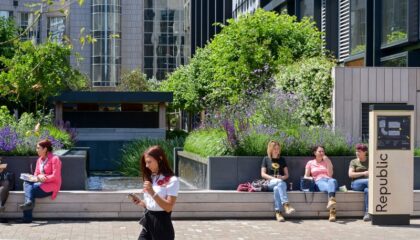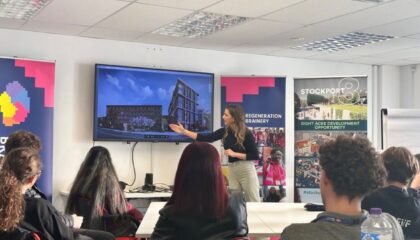How to cut through technical jargon and incorporate ESG expertise for better-performing buildings.
Lengthy reports packed with data on a building refurbishment or development may contain some of the answers for progress towards zero carbon, enhanced biodiversity or adding social value. But without the expertise to analyse and implement them, what value do they have?
Caught between a drive to reduce carbon and innovative (but possibly unproven) solutions, building owners are presented with a sea of information that doesn’t always stack up commercially.
Understanding the potential ESG gains – and the range of solutions available to deliver them – is an essential piece of the puzzle. This needs to be delivered with practical insight that cuts through an over-supply of data, to bring clarity to a broad subject area.
What’s required is a concise summary of the current status of a building’s performance versus the desired goals – and visualisation of what it would take to reach them. Workman’s new ESG Project Advisor function delivers precisely the knowledge that clients and project teams require to ensure that their ESG strategies are on track and achieve a positive commercial impact.
A barometer of progress to zero carbon
Following analysis of all ESG aspects, dashboard-style reporting is used to demonstrate the current position, the desired goal, and the actions needed to drive performance. Regular snapshots provide project teams with a barometer of their progress, together with opportunities to secure further improvements.
On projects large or small, this valuable insight makes all the difference. When involved at the initial project briefing stage, all options can be fully assessed for feasibility, allowing a menu of choices for the landlord. This enables the advisor to plot outcomes from a variety of potential scenarios, while ensuring that project ambitions are locked in. Involvement further down the line is also beneficial, allowing key performance metrics to be identified to help with marketing and leasing activity, as well as providing insight to drive the project in the right direction, providing a clear platform for managing carbon in use during the building’s operation.
The Workman ESG Project Advisor team is currently applying this expertise on a broad scope of projects with a collective value in excess of £300m, across more than 1.3m sq. ft of office, industrial and residential space. These include delivering new-build industrial units to Net Zero-ready standards, working on BTR developments to drive carbon reduction targets, and providing strategic advice for new-build office developments.
Beyond statutory compliance to achieve Net Zero
Collaboration with project teams and specialist consultants is key. This requires a combination of technical expertise: understanding the construction process as well as the client’s ESG vision. In addition to distilling hefty reports, the ESG Project Advisor will challenge and push project teams to deliver beyond statutory compliance positions. This allows clients to make informed decisions to invest in a better performing building that pays dividends over the longer term.
With some investors setting Net Zero targets as early as 2030, decisions taken now may be the last opportunity to deliver the carbon reductions required. This requires an alternative approach to design standards and product selection and project teams need to think differently about what can be delivered in order to reach zero carbon goals. Being challenged on this encourages a more detailed analysis of options that can often unlock commercial opportunities, addressing occupiers’ enthusiasm for better-performing buildings in terms of energy, carbon, health and wellbeing.
We are currently looking at options around; timber frames, CLT flooring, natural ventilation, air-source heat pumps, reducing the impact from fit-out works and careful product selection. All of which can reduce both carbon and capital outlay. Short-term and longer-term impacts around electric vehicle charging, solar PV arrays and battery storage are also a key consideration to enable day-one provision with infrastructure in place to support future expansion as demand picks up.
Greater returns and attractive savings
It’s important to note that carbon savings can often be identified without adding financial cost. It may be possible to cut embodied carbon emissions from the development simply by harnessing the expertise of our ESG Project Advisor to streamline design and specification and ensure opportunities are taken.
Investors and occupiers are both striving for more efficient buildings, not only in terms of cost, but also carbon. A marginally higher outlay at the outset of a project can deliver greater returns and attractive savings over a typical lease term. It can also make the building more attractive to occupiers, with the potential to reduce void periods.
Achieving zero-carbon goals is one of the greatest challenges faced by commercial real estate, and indeed the planet. Considering carbon-positive and cost-effective solutions at the outset of a refurbishment or development project will create a more resilient, and more valuable, asset in the longer term. And for refurbishment and development projects to have the most impact, the project team needs ESG expertise on board, from the earliest possible stage.
By Hedley Jones, Head of ESG, Refurbishment and Development, Bristol.
Read more about our ESG services
Find out about our Net Zero Asset Plans here: https://bit.ly/2QAin2x



